Raspberry Pi is perfect for home energy monitoring due to its affordability, versatility, and open-source nature. You'll find it cost-effective, with a basic setup under $100 and no subscription fees. Its compact size allows easy installation near electrical panels, while low power consumption guarantees accurate measurements. The Pi's versatile I/O capabilities let you connect various sensors, and its open-source ecosystem provides customizable software solutions. You'll benefit from real-time data processing, wireless connectivity for remote access, and integration with smart home systems. Plus, it offers educational value for DIY enthusiasts. Dive deeper to discover how this tiny computer can revolutionize your energy management.
Affordability and Cost-Effectiveness
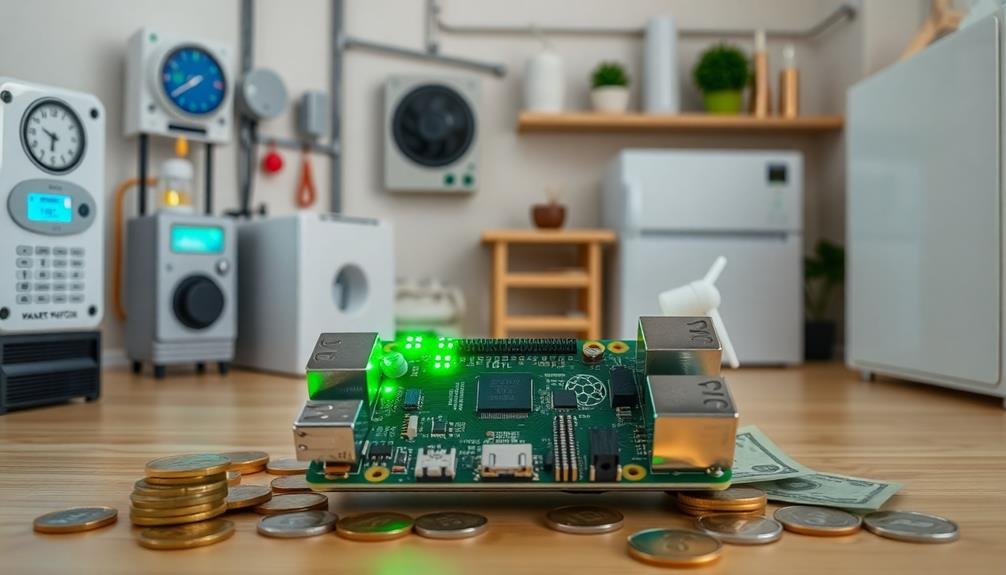
Without a doubt, one of the most appealing aspects of using a Raspberry Pi for home energy monitoring is its affordability.
You'll find that the initial investment is considerably lower compared to commercial energy monitoring systems. A basic Raspberry Pi setup costs around $35-$50, and even with additional sensors and components, you're looking at a total cost of under $100.
This makes it an accessible option for homeowners on a budget who want to take control of their energy consumption.
The cost-effectiveness doesn't end with the hardware. You'll save money in the long run by avoiding subscription fees often associated with proprietary energy monitoring systems.
With open-source software and a DIY approach, you're in complete control of your data and can customize the system to your specific needs.
You'll also benefit from the Raspberry Pi's low power consumption, which means it won't considerably impact your electricity bill while monitoring your energy usage.
Compact Size and Portability
The affordability of Raspberry Pi for home energy monitoring goes hand-in-hand with its compact size and portability. You'll find that the Raspberry Pi's small form factor, typically about the size of a credit card, makes it incredibly versatile for energy monitoring applications.
You can easily install it in tight spaces near your electrical panel or integrate it into existing smart home setups without taking up much room. The Pi's portability allows you to move your energy monitoring system between different locations in your home or even to a new residence altogether.
This flexibility is particularly useful if you're renting or planning to move soon. You won't need to leave your investment behind or go through a complicated uninstallation process.
Moreover, the compact size of Raspberry Pi-based energy monitors means you can set up multiple units throughout your home without creating clutter. This distributed approach enables more granular monitoring of energy consumption across different circuits or appliances.
You'll gain detailed insights into your energy usage patterns without sacrificing living space or aesthetics. The Pi's small size also contributes to its energy efficiency, ensuring that your monitoring solution doesn't greatly impact your overall power consumption.
Low Power Consumption
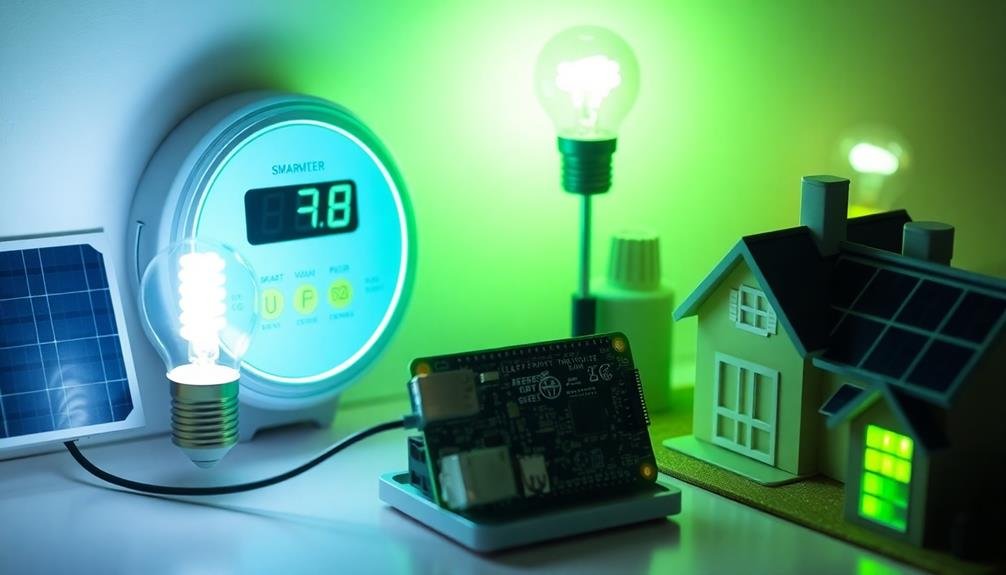
In line with its compact size, the Raspberry Pi boasts remarkably low power consumption, making it an ideal choice for continuous energy monitoring. You'll find that the device typically draws between 2 to 5 watts, depending on the model and workload. This minimal energy usage guarantees that your monitoring system won't considerably impact your overall power consumption.
When you're setting up your Raspberry Pi for energy monitoring, you'll appreciate how its low power draw contributes to accurate readings. It won't skew your measurements or add substantial overhead to your energy usage. Plus, you can easily power it using a small solar panel or battery pack for off-grid applications.
Here's a comparison of Raspberry Pi models and their power consumption:
| Model | Idle (W) | Load (W) | USB Powered | PoE Capable |
|---|---|---|---|---|
| Pi 4B | 2.7 | 5.0 | Yes | Yes |
| Pi 3B+ | 1.9 | 4.0 | Yes | No |
| Pi Zero | 0.5 | 1.0 | Yes | No |
| Pi 400 | 3.0 | 5.5 | No | No |
| Pi CM4 | 2.0 | 4.5 | No | Yes |
You'll notice that even the most power-hungry models consume less than 6 watts, guaranteeing your energy monitoring solution remains efficient and cost-effective.
Versatile Input/Output Capabilities
Versatility shines through in the Raspberry Pi's extensive input/output capabilities, making it an ideal platform for home energy monitoring.
You'll find a wealth of options to connect various sensors and devices, allowing you to create a thorough energy tracking system.
The Raspberry Pi features multiple GPIO (General Purpose Input/Output) pins, which you can use to interface with a wide range of sensors.
These pins support digital and analog inputs, enabling you to connect current sensors, voltage sensors, and power meters.
You'll also find I2C, SPI, and UART interfaces, expanding your options for more complex sensors and communication protocols.
USB ports on the Raspberry Pi let you connect additional peripherals, such as Wi-Fi adapters or storage devices.
The built-in Ethernet port guarantees reliable network connectivity for data transmission and remote access.
You can even use the HDMI port to connect a display for real-time energy consumption visualization.
With these versatile I/O capabilities, you're able to design a tailored energy monitoring system that meets your specific needs.
Whether you're tracking individual appliances or whole-house consumption, the Raspberry Pi's flexibility allows you to expand and modify your setup as required.
Open-Source Software Compatibility
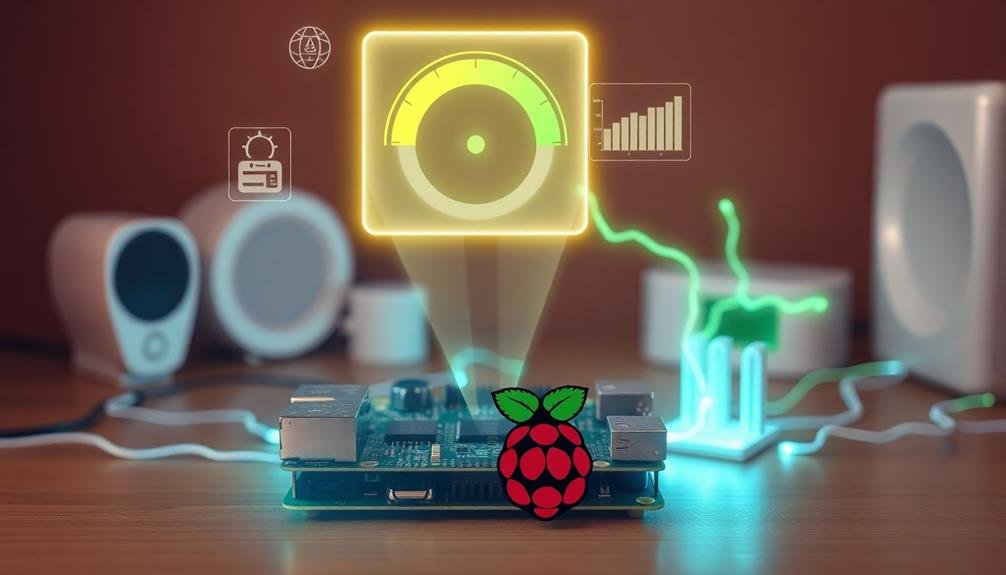
Raspberry Pi's open-source software compatibility gives you access to a vast ecosystem of tools for energy monitoring.
You'll benefit from community-driven development, which constantly improves and expands available software options.
This flexibility allows you to create customized monitoring solutions tailored to your specific home energy needs.
Wide Software Ecosystem
Open-source powerhouses like the Raspberry Pi boast a vast ecosystem of compatible software, making them ideal for home energy monitoring projects. You'll find countless applications, libraries, and tools designed specifically for energy monitoring and data analysis. From simple power consumption trackers to complex machine learning algorithms for predictive maintenance, the software options are virtually limitless.
Many of these programs are free, regularly updated, and supported by active communities. This means you can easily find help, tutorials, and resources to get your project up and running quickly. You'll also benefit from the flexibility to customize and expand your setup as your needs evolve.
| Software Type | Examples | Key Features |
|---|---|---|
| Data Collection | InfluxDB, Prometheus | Time-series databases |
| Visualization | Grafana, Matplotlib | Interactive dashboards |
| Analysis | Pandas, NumPy | Data processing libraries |
The wide software ecosystem enables you to create a thorough energy monitoring solution tailored to your specific requirements. You can combine different tools to collect data from various sensors, store it efficiently, analyze patterns, and present insights through intuitive visualizations. This versatility guarantees that your Raspberry Pi-based energy monitoring system can grow and adapt alongside your home's changing energy needs.
Community-Driven Development
Collaboration lies at the heart of the Raspberry Pi's thriving ecosystem. When you choose a Raspberry Pi for your home energy monitoring project, you're tapping into a vast network of developers, enthusiasts, and experts who continuously contribute to its growth.
This community-driven development approach guarantees that you'll have access to a wealth of open-source software, libraries, and tools specifically designed for energy monitoring applications.
You'll benefit from:
- Frequent updates and improvements to existing software
- Rapid problem-solving through community forums and discussions
- Customizable solutions that can be tailored to your specific needs
- Compatibility with a wide range of sensors and devices
- Access to extensive documentation and tutorials
The open-source nature of many Raspberry Pi projects means you can easily modify and extend existing solutions to fit your home's unique energy monitoring requirements.
You'll find numerous GitHub repositories dedicated to energy monitoring, where you can contribute your own improvements or leverage the work of others. This collaborative environment fosters innovation and guarantees that your Raspberry Pi-based energy monitoring system remains cutting-edge and adaptable to future technologies and energy management strategies.
Customizable Monitoring Solutions
Building on the collaborative spirit of the Raspberry Pi community, you'll find an abundance of customizable monitoring solutions at your fingertips. The Raspberry Pi's compatibility with open-source software allows you to tailor your home energy monitoring system to your specific needs. You can choose from a variety of existing projects or create your own, leveraging the flexibility of the platform.
Popular open-source energy monitoring software like EmonPi and OpenEnergyMonitor can be easily installed on your Raspberry Pi. These solutions offer features such as real-time energy consumption tracking, data visualization, and integration with smart home systems.
You're not limited to pre-built solutions, though. With programming languages like Python, you can develop custom scripts to collect and analyze data from various sensors connected to your Raspberry Pi.
The customizability extends to hardware as well. You can add sensors for voltage, current, temperature, and even individual appliance monitoring. This flexibility allows you to create an extensive energy monitoring system that fits your home's unique layout and energy usage patterns.
Whether you're a beginner or an experienced programmer, the Raspberry Pi's open ecosystem provides the tools and resources you need to build a personalized, efficient home energy monitoring solution.
Real-Time Data Processing
The backbone of an effective home energy monitoring system is real-time data processing. With a Raspberry Pi, you'll have the power to analyze and respond to energy consumption data as it happens. This capability allows you to make informed decisions about your energy usage instantly, potentially saving you money and reducing your environmental impact.
Your Raspberry Pi can process data from various sensors and smart devices throughout your home, giving you a thorough view of your energy consumption patterns. It's not just about collecting data; it's about making that data work for you in real-time. You can set up alerts for unusual spikes in energy use, automatically adjust smart devices based on current consumption, and even predict future energy needs based on historical data.
Here are some key benefits of real-time data processing with Raspberry Pi:
- Immediate identification of energy-hungry appliances
- Instant alerts for unexpected power consumption
- Dynamic adjustment of smart home devices
- Continuous optimization of energy usage patterns
- Real-time cost tracking and forecasting
Expandability and Customization Options
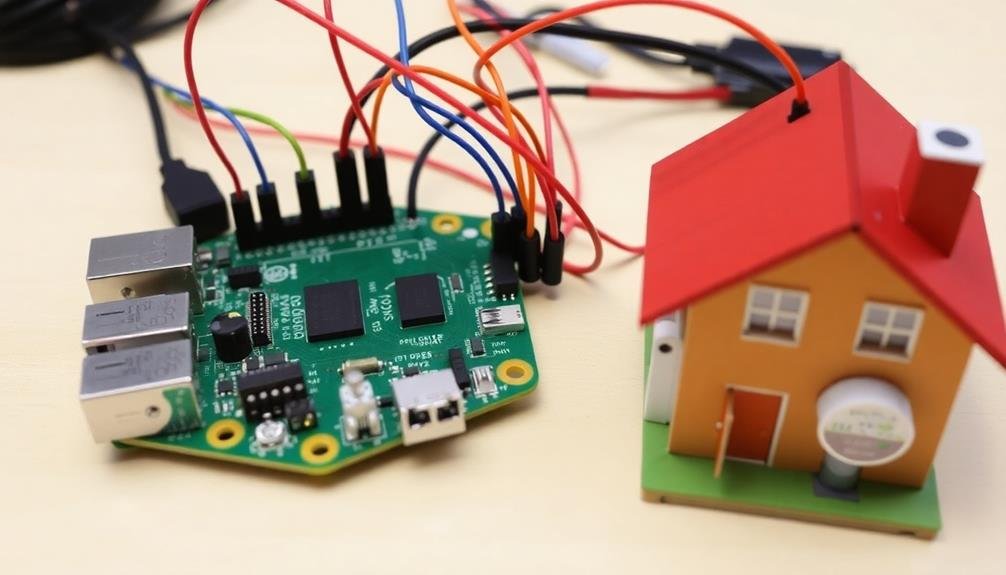
One of the greatest strengths of using a Raspberry Pi for home energy monitoring is its remarkable flexibility. You can easily expand your system's capabilities by adding various sensors and modules to track different aspects of your home's energy consumption. For instance, you might start with basic power monitoring and later add temperature sensors, smart plugs, or even solar panel integration.
The Raspberry Pi's GPIO pins allow you to connect a wide range of compatible devices, giving you the freedom to customize your setup according to your specific needs. You're not limited to pre-packaged solutions; instead, you can tailor your monitoring system to focus on the areas that matter most to you.
Moreover, the Raspberry Pi's open-source nature means you'll have access to a vast community of developers and enthusiasts. You can find countless scripts, libraries, and software solutions to enhance your energy monitoring capabilities.
Whether you want to implement machine learning algorithms for predictive analysis or create a beautiful dashboard for data visualization, the possibilities are virtually endless. This level of customization guarantees that your home energy monitoring system can grow and evolve with your changing requirements over time.
Wireless Connectivity Features
Your Raspberry Pi-based home energy monitoring system can leverage built-in Wi-Fi and Bluetooth capabilities for seamless wireless connectivity.
You'll be able to access your energy data remotely, allowing you to monitor and control your system from anywhere with an internet connection.
These wireless features also open up possibilities for IoT integration, enabling your energy monitor to communicate with other smart home devices and create a more extensive energy management ecosystem.
Wi-Fi and Bluetooth Capabilities
Raspberry Pi's wireless connectivity features make it an ideal choice for home energy monitoring projects.
You'll find both Wi-Fi and Bluetooth capabilities built into most modern Raspberry Pi models, eliminating the need for additional dongles or adapters. This integrated wireless functionality allows you to place your energy monitoring setup anywhere in your home without worrying about cable connections.
With Wi-Fi, you can easily connect your Raspberry Pi to your home network, enabling remote access and data transmission to cloud services or other devices.
Bluetooth connectivity expands your options, allowing you to pair the Pi with various sensors and smart meters for extensive energy monitoring.
Here's why these wireless capabilities are essential for your home energy monitoring project:
- Flexible placement of monitoring devices throughout your home
- Real-time data transmission to central hubs or smartphones
- Easy integration with other smart home devices and systems
- Reduced clutter and simplified installation process
- Scalability for future expansions of your monitoring setup
Remote Access Options
Once you've set up your Raspberry Pi for home energy monitoring, remote access becomes a game-changer. You'll be able to view and manage your energy data from anywhere with an internet connection. The Raspberry Pi offers several remote access options to suit your needs.
SSH (Secure Shell) is the most basic method, allowing you to access your Pi's command line remotely. It's perfect for quick checks and system maintenance.
VNC (Virtual Network Computing) takes it a step further by providing a graphical interface, letting you interact with your Pi as if you were sitting in front of it.
For a more user-friendly approach, you can set up a web server on your Pi. This allows you to create a custom dashboard accessible through any web browser. You'll be able to view real-time energy data, historical trends, and even control connected devices.
If you're always on the go, consider using a remote desktop app on your smartphone or tablet. These apps let you access your Pi's full desktop environment, giving you complete control over your energy monitoring system from the palm of your hand.
Iot Integration Potential
The Internet of Things (IoT) opens up a world of possibilities for your home energy monitoring system. With Raspberry Pi's built-in wireless capabilities, you can seamlessly integrate your energy monitor into your smart home ecosystem.
You'll be able to connect various sensors, smart plugs, and other IoT devices to create a thorough energy management network.
By leveraging IoT integration, you can:
- Automate energy-saving routines based on real-time consumption data
- Receive instant notifications about unusual energy usage patterns
- Control smart appliances remotely to optimize energy efficiency
- Integrate with voice assistants for hands-free energy monitoring
- Implement machine learning algorithms to predict and optimize energy consumption
Raspberry Pi's flexibility allows you to expand your system as new IoT technologies emerge. You can easily add new sensors or devices to your network, ensuring your energy monitoring setup stays up-to-date.
With its robust GPIO pins and support for various communication protocols, Raspberry Pi serves as an ideal hub for your IoT-enabled energy monitoring system.
You'll have the power to create a truly interconnected smart home that not only tracks energy usage but actively helps you reduce consumption and save money on your utility bills.
Easy Integration With Smart Home
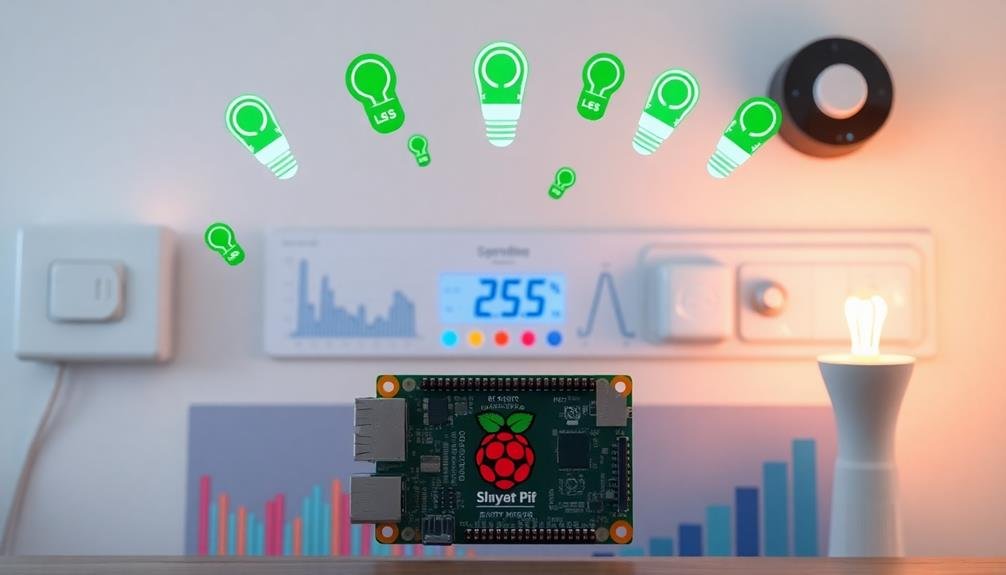
Smart home enthusiasts will be pleased to know that a Raspberry Pi-based energy monitoring system integrates seamlessly with existing smart home setups.
You'll find it easy to connect your Raspberry Pi to popular smart home platforms like Home Assistant, OpenHAB, or Apple HomeKit. This integration allows you to centralize control and visualization of your energy data alongside other smart devices.
You can use MQTT protocols to send energy consumption data from your Raspberry Pi to your smart home hub. This enables you to create custom dashboards, set up alerts, and automate actions based on energy usage patterns.
For example, you might program your smart home to turn off non-essential devices when energy consumption peaks.
The Raspberry Pi's flexibility lets you write custom scripts to interact with smart plugs, switches, and other IoT devices. You can use this to automatically control appliances based on real-time energy data.
Additionally, you can leverage voice assistants like Alexa or Google Home to query your energy usage or control your monitoring system hands-free. This level of integration makes your Raspberry Pi energy monitor a powerful addition to your smart home ecosystem.
Community Support and Resources
When you commence your Raspberry Pi energy monitoring project, you'll find a wealth of community support and resources at your fingertips.
Active online forums, such as the official Raspberry Pi forum and Reddit communities, offer a platform to ask questions, share ideas, and troubleshoot issues with fellow enthusiasts.
Additionally, you can leverage numerous open-source software libraries specifically designed for energy monitoring, which can considerably accelerate your project development and enhance its capabilities.
Active Online Forums
Enthusiasts and newcomers alike will find a wealth of support and resources in the active online forums dedicated to Raspberry Pi energy monitoring projects.
These vibrant communities are filled with passionate users who share their experiences, troubleshoot issues, and offer innovative solutions. You'll discover a treasure trove of information, from basic setup guides to advanced optimization techniques.
When you're stuck on a problem or need inspiration for your next project, these forums are your go-to resource. You can ask questions, share your own findings, and collaborate with others who share your interests.
The collective knowledge of these communities is invaluable, often surpassing official documentation regarding practical, real-world advice.
Here are some key benefits of participating in these active online forums:
- Rapid problem-solving through peer support
- Access to cutting-edge ideas and project showcases
- Opportunities for networking and collaboration
- Regular updates on new hardware and software developments
- Exposure to diverse perspectives and approaches to energy monitoring
Open-Source Software Libraries
Open-source software libraries frequently form the backbone of Raspberry Pi energy monitoring projects.
You'll find a wealth of libraries specifically designed for energy monitoring tasks, making it easier to get your project up and running quickly. Popular libraries like EmonLib and EmonPi provide ready-to-use functions for measuring voltage, current, and power consumption.
These libraries are constantly updated and improved by the community, ensuring you have access to the latest features and bug fixes.
You can easily integrate them into your Python or C++ code, saving you time and effort in developing custom solutions from scratch.
Many of these libraries also offer compatibility with various sensors and hardware components commonly used in energy monitoring setups.
Data Visualization Possibilities
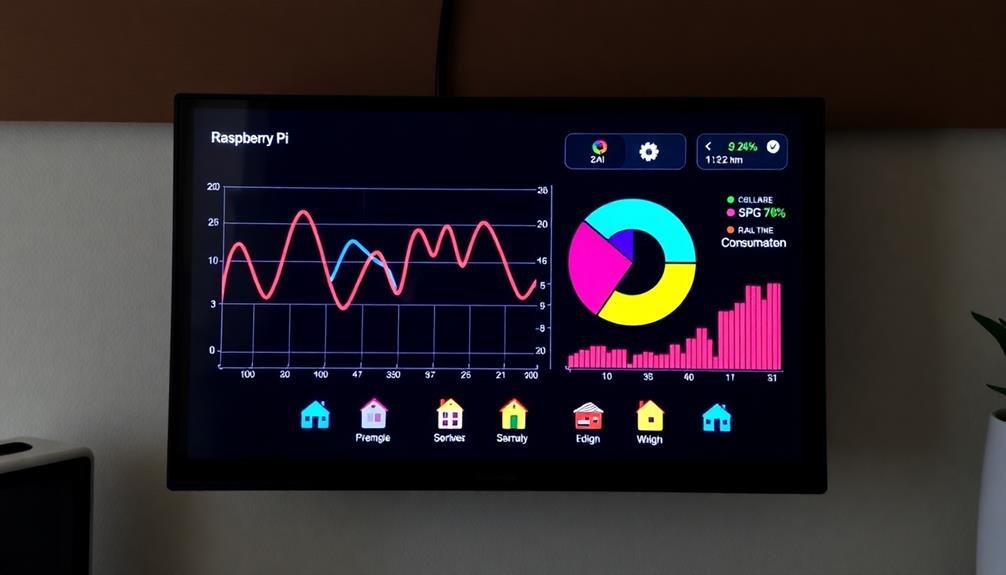
Three key aspects make data visualization essential for home energy monitoring with Raspberry Pi: real-time insights, trend analysis, and user-friendly presentation.
With your Raspberry Pi setup, you'll have access to a wealth of energy consumption data. Transforming this raw information into visually appealing charts, graphs, and dashboards allows you to quickly grasp your home's energy usage patterns.
You can leverage various data visualization tools and libraries compatible with Raspberry Pi, such as Matplotlib, Plotly, or Grafana. These tools enable you to create interactive dashboards that display your energy data in real-time.
You'll be able to track your daily, weekly, or monthly consumption trends, identify peak usage hours, and spot anomalies effortlessly.
Here are some key benefits of data visualization for home energy monitoring:
- Simplifies complex data for easy interpretation
- Enables quick decision-making for energy-saving measures
- Facilitates comparison of energy usage across different time periods
- Helps identify energy-hungry appliances or behaviors
- Motivates household members to adopt energy-efficient practices
Long-Term Reliability and Durability
While data visualization helps you understand your energy usage, it's equally important to guarantee your Raspberry Pi setup can withstand the test of time.
Raspberry Pi's long-term reliability and durability make it an excellent choice for home energy monitoring. The device's solid-state design means there are no moving parts to wear out, reducing the risk of mechanical failures.
You'll find that Raspberry Pi's low power consumption generates minimal heat, which contributes to its longevity. To further enhance durability, consider housing your Pi in a protective case that shields it from dust and accidental impacts.
Proper ventilation within the case will help maintain ideal operating temperatures.
Regular software updates and backups are essential for maintaining system integrity. You can set up automatic updates to make certain your Pi always runs the latest, most secure software.
For added reliability, implement a UPS (Uninterruptible Power Supply) to protect against power outages and voltage fluctuations.
Raspberry Pi's robust community support means you'll have access to troubleshooting resources and firmware updates for years to come.
This ongoing support contributes markedly to the long-term viability of your home energy monitoring system.
Educational Value for DIY Enthusiasts
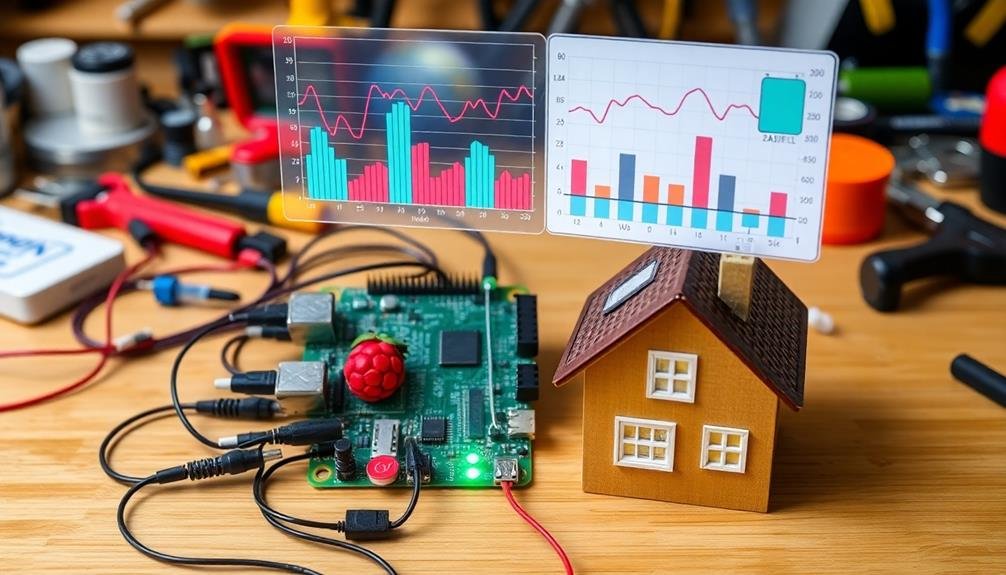
DIY enthusiasts will find that setting up a Raspberry Pi for home energy monitoring offers a wealth of educational opportunities.
You'll gain hands-on experience with hardware integration, software development, and data analysis. As you work through the project, you'll learn about electrical systems, sensor technology, and energy consumption patterns in your home.
The process of building and configuring your monitoring system will enhance your programming skills, particularly in Python—a versatile language widely used in data science and IoT applications.
You'll also become familiar with database management, as you'll need to store and retrieve the energy data collected by your Raspberry Pi.
This project provides valuable insights into:
- Basic electronics and circuit design
- IoT device configuration and management
- Data visualization techniques
- Energy-saving strategies and home automation
- Real-world application of machine learning algorithms
Frequently Asked Questions
How Does Raspberry Pi Compare to Other Microcontrollers for Energy Monitoring?
You'll find Raspberry Pi outperforms many microcontrollers for energy monitoring. It's more powerful, versatile, and user-friendly. With its built-in Wi-Fi and extensive GPIO pins, you can easily connect sensors and transmit data for real-time energy tracking and analysis.
Can Raspberry Pi Handle Monitoring Multiple Energy Sources Simultaneously?
Yes, you can use Raspberry Pi to monitor multiple energy sources simultaneously. It's powerful enough to handle various inputs and process data in real-time. You'll need appropriate sensors and software, but it's definitely capable of multi-source monitoring.
What Security Measures Can Be Implemented When Using Raspberry Pi for Energy Monitoring?
You can implement several security measures: Use strong passwords, enable SSH key authentication, update regularly, install a firewall, encrypt data, restrict network access, and use VPNs. Don't forget to secure your network and physical device too.
Are There Pre-Built Energy Monitoring Kits Available for Raspberry Pi?
Yes, you'll find several pre-built energy monitoring kits for Raspberry Pi. They often include current sensors, voltage sensors, and necessary software. You can easily set them up without extensive technical knowledge. Popular options include OpenEnergyMonitor and CircuitSetup's Energy Monitoring Shield.
How Accurate Is Raspberry Pi in Measuring Energy Consumption Compared to Professional Equipment?
You'll find Raspberry Pi can be quite accurate for energy monitoring. It's not as precise as professional equipment, but with the right sensors and calibration, you'll get reliable measurements for home use. It's a cost-effective solution for most consumers.
In Summary
You've discovered why Raspberry Pi is ideal for home energy monitoring. It's affordable, compact, and energy-efficient, with versatile I/O capabilities. You'll benefit from open-source software, a supportive community, and data visualization options. It's reliable for long-term use and offers educational value. Whether you're a DIY enthusiast or just looking to save on energy costs, Raspberry Pi provides the perfect platform to monitor and optimize your home's energy consumption.

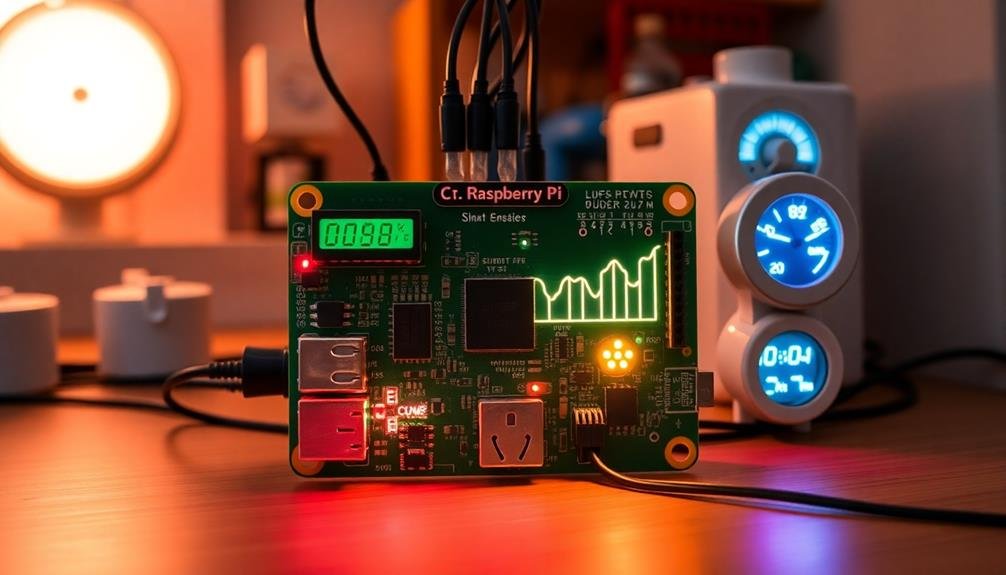

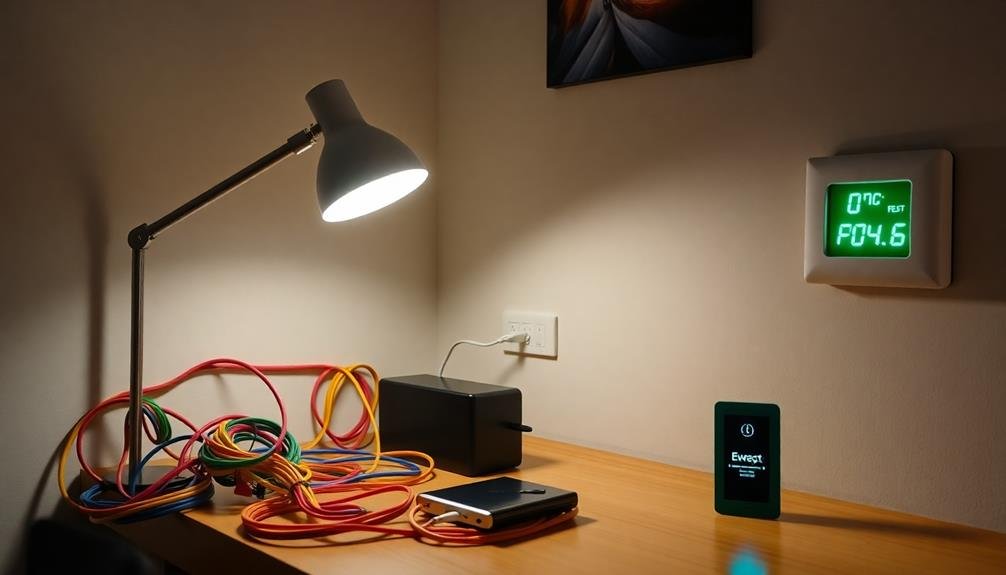
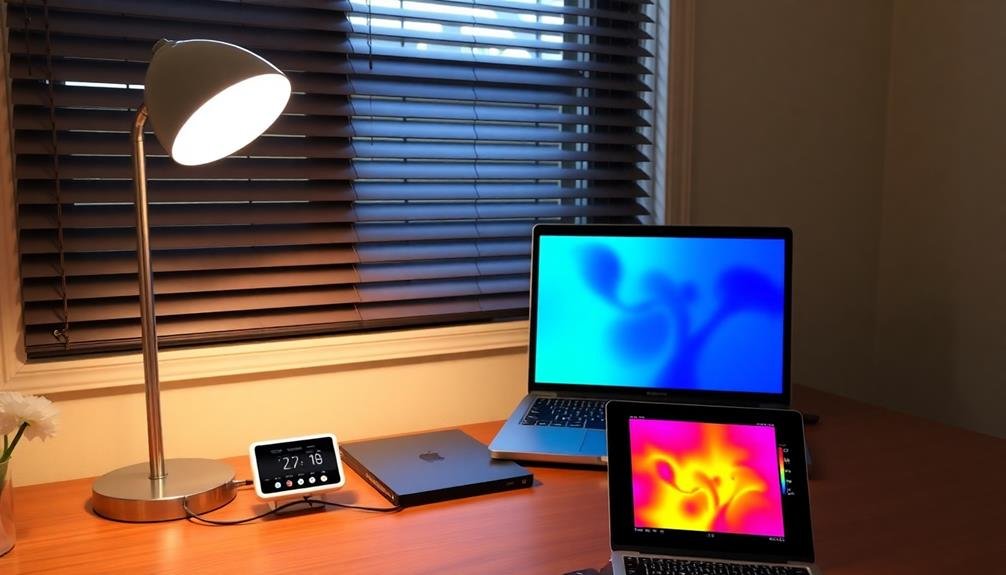
Leave a Reply